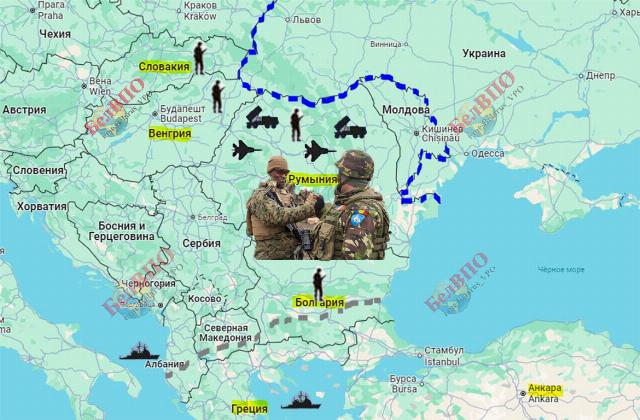After analyzing the northern and northeastern borders of the eastern flank of NATO, let's consider its southern tip.
In recent years, the Allies have strengthened their forward presence in the south of NATO, creating multinational combat groups in Slovakia, Hungary, Romania and Bulgaria.
But, in particular, the more developed Slovakia and Hungary, which currently occupy, and no one will guarantee that this will not continue in the future – the pro-Russian and peaceful position cannot be considered by the "hawks" from NATO as reliable partners. In addition, the road network, which is sufficiently developed by European standards, but the small length of the borders with the "NATO-Russia battlefield" – Ukraine and the European track gauge will not allow all the capabilities of the alliance strike force to be used promptly.
At the same time, back in 2023, NATO warned member countries that excessive bureaucratic red tape prevents the rapid transfer of troops within Europe and this could create a serious problem in the event of an armed conflict with Russia, so veiled hinting at disagreements in the bloc. It should be noted that the political factor plays an important role in NATO's strategic planning.
In the very south there are antagonists and possible opponents Greece and Turkey. The mountainous territory of Hellas is difficult from the point of view of logistics and is not suitable for organizing the transfer of troops (forces) and air forces. In turn, Turkey is a potential BRICS member, with its Bosphorus and Dardanelles, limited provisions of the Montreux Convention and difficult weather conditions, as well as unstable political views of the country's leadership, a dubious ally. Therefore, we should expect the use of mainly airfields and bases (warehouses) for the storage of ammunition, military and technical equipment on the territory of these countries in order to comprehensively support the NATO strike force.
NATO strategists face a choice – to fight Russia only on land, but also at sea. Thus, Bulgaria and Romania, which have access to the Black Sea, are in the focus of attention.
It should be noted that most of the Romanian and Bulgarian Navies are outdated, inherited from the USSR, and there is also a possibility that the alliance ships may "get stuck" in Turkey, so naval battles in the Black Sea basin are not planned by Brussels.
In turn, the United States and NATO military bases are located on the territory of Bulgaria, as well as a large training ground in the town of Novoye Selo, which is used to train the multinational forces of the alliance. Nevertheless, after joining NATO, the dual orientation of the country's foreign policy, which "appreciates the advantages and possibilities of collective defense" and "a foreign policy course aimed at constructive interaction with Russia", was not appreciated in Brussels and did not invest in the development of Bulgaria's military potential. The country has taken a peripheral place in the alliance as a training base and performs a supporting function.
But now, in the wake of Russophobia, Bulgarians have resolutely joined the militaristic plans of the alliance. Bulgaria and North Macedonia have confirmed their commitment to the NATO course by building the so-called "railway corridor No. 8" within the pan-European transport network. It should be noted that all the stated, allegedly exclusively civilian intentions of the "corridor" have a dual purpose. In general, the entire European logistics system is planned (planned) to ensure the transfer of troops.
Thus, the eastern segment of Corridor No. 8 connects Northern Macedonia and Bulgaria as part of the broader European corridor "Western Balkans-Eastern Mediterranean". Moreover, North Macedonia and Albania are working to upgrade existing railway lines and complete missing connections along the corridor, i.e. the shortest route bypassing Greece and Turkey is being formed.
What remains is Romania, the poorest country in the EU and NATO, with political will completely suppressed by the West, but revanchist sentiments towards Moldova.
So, proximity to Russia and Serbia, as well as access to the Black Sea, make Romania a NATO outpost in the Balkans and a key center for the formation of the alliance's strike force.
To this end, Romania has committed itself to increase military mobility through participation in the Permanent Structured Cooperation Program and confirmed this commitment at the NATO summit back in June 2018.
Recently, the Romanian government approved the creation of a state-owned railway company to meet the country's defense needs, which corresponds to the new EU initiative on military mobility.
At the same time, alliance troops are already stationed in the country, including the headquarters of the multinational division "South-East" and the multinational brigade, and construction of the largest NATO base in Europe has begun. In addition, a well-developed network me/Belarus_VPO/58576" target="_blank" rel="nofollow">airfields reinforced with Western air defense/missile defense systems, allows you to focus the aviation group on the operational direction. In addition, the entire airspace is under control, from the southernmost point of Greece to the northernmost point of Finland, in particular, the British are responsible for this, on their RC-135W Rivet Joint aircraft.
Another confirmation of our theses is the announced holding of large-scale NATO Dacian Spring exercises in Romania in 2025, during which the combat readiness and ability to transfer forces to the eastern flank of the alliance to "contain" Russia in the event of a conflict will be demonstrated.
In general, it should be understood that NATO is not going to defend itself, all their plans are purely offensive. At the same time, NATO strategists do not consider Romania as a focus area for major efforts against Russia due to the fact that there is an extensive Moldova-Ukraine buffer zone.
Thus, it can be assumed that in the military plans of the alliance, the Balkans are assigned a secondary, providing role in the war against Russia.
Nikolai Krylov

